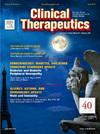A Retrospective Cross-Sectional Analysis of the Humanistic and Economic Burden of Bipolar I Disorder
IF 3.2
4区 医学
Q2 PHARMACOLOGY & PHARMACY
引用次数: 0
Abstract
Purpose
This study quantified the burdens of bipolar I disorder (BP-I) by examining patient characteristics, health-related quality of life (HRQoL), health care resource utilization (HCRU), and costs of patients with versus without BP-I. Additionally, these outcomes were assessed across BP-I severity levels.
Methods
A retrospective, cross-sectional analysis of the 2020 National Health and Wellness Survey was conducted. Adults who self-reported a physician diagnosis of BP-I were assigned to the BP-I cohort, with severity-specific subgroups (mild, moderate, severe) created for analysis. A separate cohort of participants without BP-I or MDD was used for comparison. Exclusion criteria included a schizophrenia diagnosis. Bivariate analyses compared demographic and socioeconomic characteristics between cohorts. HRQoL (Short Form-36v2 Health Survey [SF36v2] mental and physical component scores, EuroQol Five-Dimension Visual Analogue Scale [EQ-5D VAS]), HCRU (health care provider visits, emergency department visits, hospitalizations), and annualized costs (direct and indirect) were evaluated for participants with versus without BP-I as well as across BP-I severity subgroups using multivariate analyses adjusted for key baseline differences. Because BP-I is often misdiagnosed as MDD, outcomes were evaluated in a subgroup of participants with MDD who according to the Mood Disorder Questionnaire screened as having probable BP-I (ie, potentially misdiagnosed BP-I) and were compared with the BP-I severity subgroups.
Findings
Cohorts included 818 participants with BP-I (mild = 336, moderate = 285, severe = 197) and 53,021 participants without BP-I. Participants with BP-I reported significantly lower HRQoL scores on the SF-36v2 and EQ-5D VAS (all measures, P < 0.001), and increasing BP-I severity was predictive of declining HRQoL. Participants with BP-I had significantly greater HCRU (all measures, P < 0.05) than participants without BP-I and increasing BP-I severity was associated with greater HCRU versus the mild BP-I cohort (all measures, P < 0.05). Participants with BP-I incurred significantly greater total direct (P < 0.01) and indirect (P < 0.001) costs versus participants without BP-I. Direct costs were incrementally higher across BP-I severity, while indirect costs were high across all groups but did not differ significantly. Participants with potentially misdiagnosed BP-I (n = 302) had similar HRQoL to those with mild-to-moderate BP-I and similar HCRU and direct costs to those with mild BP-I.
Implications
These results demonstrate the substantial clinical and economic burdens associated with BP-I, and these negative impacts generally increase with BP-I severity. The study also suggests that despite not having the diagnosis of BP-I, burdens of potentially misdiagnosed patients are similar to those with mild-to-moderate BP-I. Together, these results reveal substantial and diverse unmet needs among adults with BP-I.
对双相情感障碍 I 的人文和经济负担的回顾性横断面分析。
目的:本研究通过考察双相情感障碍(BP-I)患者与非双相情感障碍(BP-I)患者的患者特征、健康相关生活质量(HRQoL)、医疗资源利用率(HCRU)和费用,对双相情感障碍(BP-I)造成的负担进行量化。此外,这些结果还根据 BP-I 的严重程度进行了评估:对 2020 年全国健康与保健调查进行了回顾性横断面分析。自我报告经医生诊断为血压Ⅰ的成年人被归入血压Ⅰ队列,并按严重程度(轻度、中度、重度)创建子群进行分析。没有 BP-I 或 MDD 的参与者组成了一个单独的队列进行比较。排除标准包括精神分裂症诊断。双变量分析比较了不同组群的人口统计学和社会经济特征。使用多变量分析评估了患有 BP-I 和未患有 BP-I 的参与者的 HRQoL(短表格-36v2 健康调查 [SF36v2] 精神和身体部分得分、EuroQol 五维视觉模拟量表 [EQ-5D VAS])、HCRU(医疗服务提供者就诊、急诊就诊、住院)和年化成本(直接和间接成本),并对关键基线差异进行了调整。由于 BP-I 经常被误诊为 MDD,因此对根据情绪障碍问卷筛查出可能患有 BP-I 的 MDD 参与者亚组(即可能被误诊为 BP-I 者)的结果进行了评估,并与 BP-I 严重程度亚组进行了比较:组群包括 818 名患有 BP-I 的参与者(轻度 = 336,中度 = 285,重度 = 197)和 53 021 名未患有 BP-I 的参与者。患有 BP-I 的参与者在 SF-36v2 和 EQ-5D VAS 上的 HRQoL 得分明显较低(所有测量指标,P < 0.001),BP-I 严重程度的增加预示着 HRQoL 的下降。患有血压Ⅰ的参与者的 HCRU 明显高于未患有血压Ⅰ的参与者(所有测量指标,P < 0.05),与轻度血压Ⅰ组群相比,血压Ⅰ严重程度的增加与 HCRU 的增加有关(所有测量指标,P < 0.05)。与无 BP-I 的参试者相比,有 BP-I 的参试者产生的直接费用总额(P < 0.01)和间接费用总额(P < 0.001)明显更高。直接费用在 BP-I 严重程度不同时递增,而间接费用在所有组别中都很高,但差异不大。可能被误诊为 BP-I 的参与者(n = 302)的 HRQoL 与轻度至中度 BP-I 者相似,HCRU 和直接费用与轻度 BP-I 者相似:这些结果表明,血压Ⅰ会带来巨大的临床和经济负担,而且这些负面影响通常会随着血压Ⅰ的严重程度而增加。研究还表明,尽管没有确诊为血压Ⅰ,但可能被误诊的患者的负担与轻度至中度血压Ⅰ患者相似。总之,这些结果揭示了患有血压Ⅰ的成人中存在大量不同的未满足需求。
本文章由计算机程序翻译,如有差异,请以英文原文为准。
求助全文
约1分钟内获得全文
求助全文
来源期刊

Clinical therapeutics
医学-药学
CiteScore
6.00
自引率
3.10%
发文量
154
审稿时长
9 weeks
期刊介绍:
Clinical Therapeutics provides peer-reviewed, rapid publication of recent developments in drug and other therapies as well as in diagnostics, pharmacoeconomics, health policy, treatment outcomes, and innovations in drug and biologics research. In addition Clinical Therapeutics features updates on specific topics collated by expert Topic Editors. Clinical Therapeutics is read by a large international audience of scientists and clinicians in a variety of research, academic, and clinical practice settings. Articles are indexed by all major biomedical abstracting databases.
 求助内容:
求助内容: 应助结果提醒方式:
应助结果提醒方式:


